Rex Mays, Peter Giddings and the Alfa Tipo C 8C35
By Pete Vack
Color photos by www.rprincephoto.com
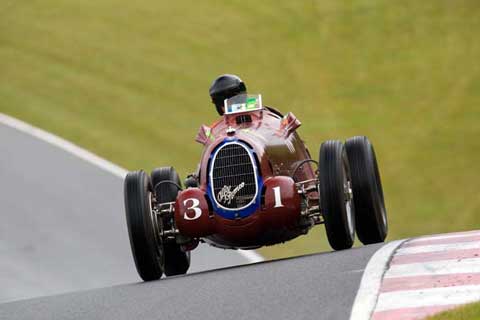
Giddings at Mt Tremblant with the Tipo C, 8C35 Grand Prix car.
Given the might of the Mercedes and Auto-Union teams, the Alfa Romeo 8C35 had a brief but reasonably successful two seasons in Europe. Designed to be fitted with either a V12 engine, or an 8 cylinder, the 8C35 used a longer version of the famous Alfa 8C 2.3 engine, running almost concurrently with the initially unreliable V12 (12C36) while it was being developed. In 1936 Tazio Nuvolari drove the 8C35 to great victories at Coppa Ciano and the Hungarian GP.
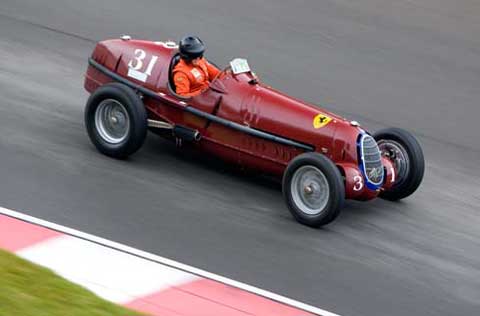
Classic image; only the helmet and Nomex betray the era.
But it was an American who was the real hero of the 8C35 saga. Rex Mays was described as a “full throttle driver” but he was brilliant as well. He raced for the wealthy Bill White who purchased one of the 8C35s which had been brought over for the 1936 Vanderbilt Cup (won by Nuvolari in the new 12C36).
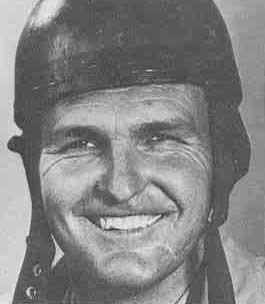
Rex Mays, unheralded American Hero.
According to Brock Yates in his book, “Ferrari”, White asked Alfa mechanic Attilio Marinoni to remain with the car for a few weeks, during which time Marinoni was said to have spilled all the tuning secrets of the 8C engine. Whatever, Mays widened the body for the still-required riding mechanic for the Indianapolis race in 1937, but retired with overheating problems. The 8C35 was then returned to monoposto form for the Vanderbilt Cup.
There, Rex Mays placed third in his first road race, his first Grand Prix, against the same German teams which were laying waste to everything else on tracks around the world. Mays astounded the Europeans with both his driving skills and the speed of the old Alfa 8C35.
Americans were not as surprised. Mays was born in 1913 in Riverside, California and learned his trade at the Ascot Speedway. In 1934 and 1935 he had won the AAA Pacific Coast Championship and entered his first of twelve Indy 500s in 1934. Mays was on the pole in 1935 and 1936 at Indy. Everyone knew the guy had talent, at least on this side of the pond.
The Vanderbilt Cup race would be the perfect stage for him to demonstrate his skills to his peers from the other side of the water. From 1904 to 1909 Vanderbilt Cup races were run on public roads in Long Island (part of the 1904 race was run through Queens!). The Cup races were then run at Savannah, and three locations on the West Coast before WWI. The series was re-instituted at New York’s Roosevelt Raceway in 1936. For the 1937 races, the German teams crossed the Atlantic to take part. Rudolph Caracciola and Richard Seaman drove for Mercedes, while the Auto Union team consisted of Berndt Rosemeyer and Ernest von Delius.
Mays had qualified third fastest, so was behind Caracciola and Rosemeyer, who quickly sped off and battled for the lead. Caracciola’s Mercedes retired and Rosemeyer and Seaman then tangled for the top two spots. But right behind them, driving the race of his life, was Rex Mays, in a car that was at least two years out of date. Must we say that the crowds went wild when Mays finished ahead of the Auto Union of von Delius and behind Seaman for third place? Nuvolari retired the 12C36 on lap 17 and was never in contention.
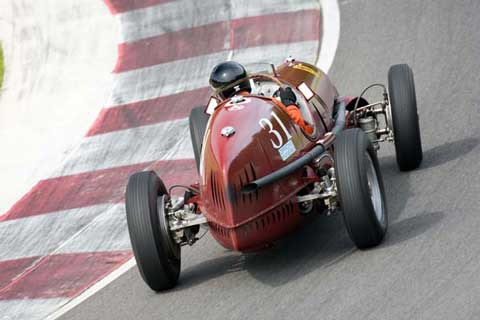
Rear view shows a bit of the early VW-like swing axles.
After the race, there are several versions of what transpired. Yates and others agree that Scuderia Ferrari or Alfa Romeo asked Mays to come to Italy to join the team. Before leaving New York for Italy, Mays was informed that he needed a tuxedo. Mays was not a tux kind of guy and headed back to California. Others, including Alfa 8C expert Simon Moore, think that Alfred Neubauer also offered him a place on the Mercedes Benz team. Whatever the truth, Mays was now a hero to the Europeans as well as the Americans. ” The race,” wrote the New York Times, “showed that driver for driver, the Americans are on par with their foreign rivals, even though their style of racing on ovals here has not given them the greatest experience in road racing.”
But the 8C35, engine/chassis #50012, was not done yet. Next, Fred Offenhauser and Ed Winfield got involved with modifying the engine, reducing the bore and stroke from the original 3.8 liters to 3 liters for the new 1938 International regulations. This was quite involved but was done by two geniuses. With a two speed rear end, the old Alfa entered the Indy classic again in 1938 driven by Mays, but retired after 45 laps. In other hands, the Alfa continued to qualify in five more Indy 500s until 1947. Mays went on to more competitive cars. After four pole positions at Indy but no wins, Rex Mays died in a crash at Del Mar, California in 1949.
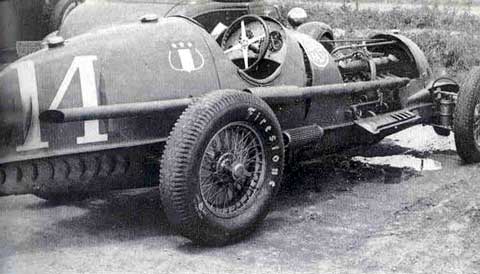
The Mays car, chassis #50012, at the Vanderbilt Cup, 1937.
Sometime after WWII, 50012’s engine was separated from the chassis. The warhorse now had a Chevy six inserted into the chassis, and was eventually found by Michael Agraba, who in turn sold the sad remains to the Alfa Museum in 1968. The museum then fitted the restored chassis with a V12c 36 engine, and as such it is still on display at Arese.
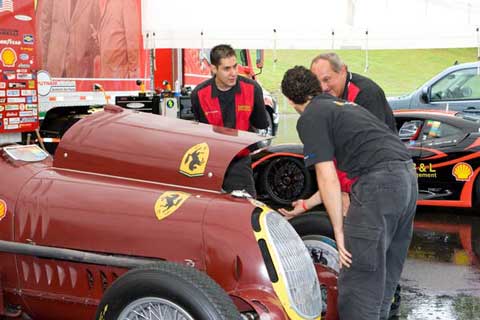
A truly rare occurrence; two 8C 35s at the same event.
According to Simon Moore the Alfa-Offy engine was found under a workbench in Fresno, California and went through several hands before ending up with Peter Giddings. Giddings then used the engine in his Alfa 8C35 frame #8. As the chassis number cannot at this time be verified, Giddings simply calls this an Alfa Tipo C 8c35 (frame #8/ engine 50012).
In building up Giddings’ current car, Auto Restorations of Christchurch, New Zealand had the benefit of comparing the only fully original 8c35 in existence, chassis #50013. The car is set up as it would have been driven by Nuvolari or Mays. “As far as improvements are concerned, I prefer (in so far as all of my cars are concerned) to wrestle them as original, warts and all”, said Giddings.
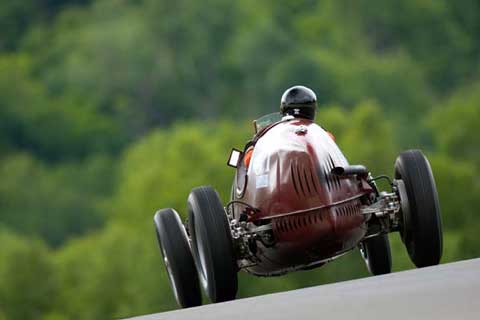
A classic Richard Prince angle.
This means that the handling is “of the era” and as tricky as can be. It is no secret that even Nuvolari hated the handling of the 8C35, with its swing axles. Giddings says “The change from understeer to oversteer (and everything in between) is substantially as a result of one’s right foot.
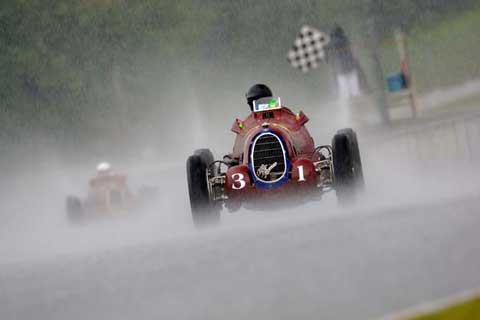
Giddings in the rain, finishing just ahead of Peter Greenfield in the other Tipo C 8C35.
The transition can never be trusted. Thus a joyous battle ensues, right foot / brain vs. Italian vagary — usually (but not always) the hapless driver wins!” And that is under dry conditions. “Let’s just say that a Tipo C in the dry is like “soap on marble” and in the wet? Well, words fail me” said Giddings, who experienced very wet weather at Mt. Tremblant but went on to win the drum brake races anyway.
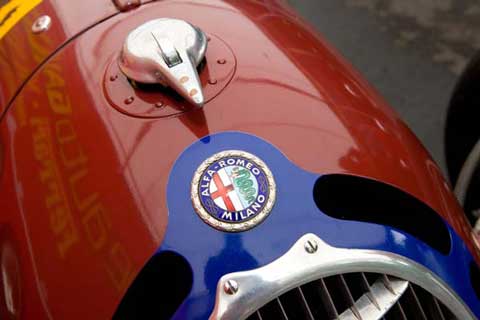
Part II of the Titans will deal with the two Alfa 8C35s of Peter Greenfield.
Thanks for this story!
Just a question: Are you sure that the “50012” run four Indy 500 from 1939 to 1947 and not five?
1939 – #31 – Babe Stapp – 5th
1940 – #41 – Harry McQuinn – 11th
1941 – #15 – Harry McQuinn (relief driver Kelly Petillo) – 7th
1946 – #63 – Jimmy Wilburn – DNF 52 laps
1947 – #34 – Cy Marshall – 8th
Am’I wrong?
PS: the B&W picture show the “monoposto” from the 1937 Vanderbilt Cup.
Regards
Jyl
Jean-Yves
You are correct in stating there were five Indys. Good catch on the date of the B&W Mays photo at the Vanderbilt Cup, and we have changed the caption. Thanks again for your interest and depth of knowledge!!!
Pete Vack
One of the 8C-35’s resides in the Indianapolis Speedway Museum and is frequently displayed at Major Coucours. I saw one raced during my first 500 in 1947 with ALFA’s finishing 8th and 9th.
What an interesting article on the old Alfa! I’d like to see more historical material like this, especially on the little-known marques that turned up in formula racing in the early postwar years.
And hello to Dr. Etceterini! We were in touch some years ago when I was a big-time collector and small-time dealer. Now I collect only racing and speed record cars and don’t deal at all. Despite a rumor that I was dead, I am still alive, 70 years old, and still following old and new Formula 1.
All the best,
Uncle Ed
What a nice write-up about my dad. Thank you.
Sue
Per Peter Giddings–
The Indy Museum has an Alfa 308 [not a 8C35 as Goddard reports] (but I don’t believe it ever ran at Indy?) plus, of course, the fabulous Maserati 8CTF.
It’s important to keep the record straight.